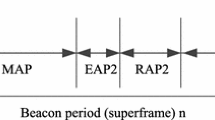Abstract
Recently, the significance of internet of things (IoT) is rapidly growing in the next generation of information and communication technology due to rapid advances in wireless communication technologies which have triggered the development of low-power, reliable and miniaturized devices. These advances lead to the creation of IoT ecosystem that enables development of various services. Especially, there are a number of attempts to apply communication technology of IoT in the field of healthcare services which deals with medical applications such as a remote medical treatment. In IoT-based healthcare system, in general, a number of medical devices are densely deployed in narrow area. Therefore, they are exposed to signal interference among them which causes significant performance degradation. In this paper, we present an Analytical Hierarchy Process (AHP)-based network interface and channel selection algorithm for multi-channel MAC protocols in IoT ecosystem that take into account a multitude of decision factors, such as expected channel condition, latency and frame reception ratio. The proposed scheme can provide flexibility for various requirements of different medical services through performing AHP. In particular, the proposed scheme considers IoT-based healthcare system because it is the most complex scenario of fundamental IoT applications. To evaluate the performance of the proposed algorithm, we perform extensive simulations, and the simulation study shows that the proposed algorithm provides low latency and high reliability.










Similar content being viewed by others
References
Bandyopadhyay, D., & Sen, J. (2011). Internet of things: Applications and challenges in technology and standardization. Wireless Personal Communications, 58(1), 49–69.
Kim, S., & Na, W. (2016). Safe data transmission architecture based on cloud for internet of things. Wireless Personal Communications, 86(1), 287–300.
Kim, S. (2015). QoS-aware data forwarding architecture for multimedia streaming services in hybrid peer-to-peer networks. Peer-to-Peer Networking and Applications, 8(4), 557–566.
Kim, S., & Suk, J. (2016). Efficient peer-to-peer context awareness data forwarding scheme in emergency situations. Peer-to-Peer Networking and Applications, 9(3), 477–486.
Kim, D., Cho, J., & Lee, B. (2010). A buffer management technique for guaranteed desired communication reliability and low-power in wireless sensor networks. IEICE Transactions on Communications, E93–B(12), 3522–3525.
Koien, G. M. (2011). Reflections on trust in devices: An informal survey of human trust in an internet-of-things context. Wireless Personal Communications, 61(3), 495–510.
Jung, E., Kim, J., Chung, K., & Park, D. K. (2013). Home health gateway based healthcare services through U-health platform. Wireless Personal Communications, 73(2), 207–218.
Cavallari, R., Martelli, F., Rosini, R., Buratti, C., & Verdon, R. (2014). A survey on wireless body area networks: Technologies and design challenge. IEEE Communications Survey & Tutorials, 16(3), 1635–1657.
IEEE 802.15 WPAN Task Group 6 (TG6) Body Area Networks. http://www.ieee802.org/15/pub/TG6.html
IEEE standard for local and metropolitan area networks - Part 15.6 (2012). Wireless body area networks. In: IEEE Std 802.15.6-2012 (pp. 1–271).
Zhen, B., Patel, M., Lee, S., Won, E., & Astrin, A. (2008). TG6 Technical Requirements Document (TRD). In IEEE P802.15-08-0644-05-0006.
Hayajneh, T., Almashaqbeh, G., Ullag, S., & Vasilakos, A. V. (2014). A survey of wireless technologies coexistence in WBAN: Analysis and open research issues. Wireless Personal Communications, 20(8), 2165–2199.
Yuan, W., Wang, X., & Linnartz, J. (2007). A coexistence model of IEEE 802.15.4 and IEEE 802.11b/g. In Proceedings of 14th IEEE symposium on communication and vehicular technology in the Benelux (pp. 1–5).
Huang, J., Xing, G., Zhou, G., & Zhou, R. (2010). Beyond co-existence: Exploiting WiFi white space for zigbee performance assurence. In Proceedings of IEEE international conference on network protocols (pp. 305–314).
de Francisco, R., Huang, L., & Dolmans, G. (2009). Coexistence of WBAN and WLAN in medical environments. In Proceedings of IEEE 70th vehicular technology conference fall (VTC 2009-Fall) (pp. 1–5).
Cho, B. M., Park, K. J., & Park, E. C. (2014). Contention window adaptation for coexistence WBAN and WLAN in medical environments. In Proceedings of international conference on information and communication technology convergence (ICTC 2014) (pp. 945–946).
Tang, Z., & Garcia-Luna-Aceves, J. J. (1999). Hop- reservation multiple access (HRMA) for ad-hoc networks. In Proceedings of IEEE INFOCOM 1999 (pp. 194–201).
Zhang, H., & Li, S. (2011). A practical design of multi-channel MAC for cluster-tree WSN. In Proceedings of 6th IEEE international forum on strategic technology (IFOST 2011) (pp. 22–24).
Abdeddaim, N., Theoleyre, F., Rousseau, F., & Duda, A. (2012). Multi-channel cluster tree for 802.15.4 wireless sensor network. In Proceedings of 23rd IEEE international symposium on personal indoor and mobile radio communications (PIMRC 2012) (pp. 590–595).
Lee, W., Rhee, S. H., Kim, Y., & Lee, H. (2009). An efficient multi-channel management protocol for wireless body area networks. In Proceedings of IEEE international conference on information networking (ICOIN 2009) (pp. 1–5).
Ivanov, S., Botvich, D., & Balasubramaniam, S. (2012). Cooperative wireless sensor environment supporting body area network. IEEE Transactions on Consumer Electronics, 58(2), 284–292.
Kim, D., Jin, Z., Choi, J., Lee, B., & Cho, J. (2015). Transmission power control with the guaranteed communication reliability in WSN. International Journal of Distributed Sensor Networks, 2015(632590), 2015.
Kim, B., Kim, D., & Cho, J. (2011). An emergency handling scheme for superframe-structured MAC protocols in WBANs. IEICE Transactions on Communications, E–94B(12), 2484–2487.
Saaty, T. L. (2000). Fundamentals of decision making and priority theory with the analytic hierarchy process. Pittsburgh: RWS Publications.
Song, Q. Y., & Jamalipour, A. (2005). A network selection mechanism for next generation networks. In Proceedings of IEEE international conference of communication 2005 (ICC2005), Seoul, Korea (pp. 1418–1422).
Heinzelman, W. R., Chandrakasan, A., & Balakrishnan, H. (2000). Energy-efficient communication protocol for wireless microsensor networks. In Proceedings of Hawaii international conference on system sciences 2000 (HICSS 2000), Maui, Hawaii, (pp. 3005–3014).
Acknowledgments
This research was supported by Basic Science Research Program through the National Research Foundation of Korea (NRF) funded by the Ministry of Education (2014R1A1A2060035), and this work was supported by the Soonchunhyang University Research Fund.
Author information
Authors and Affiliations
Corresponding author
Rights and permissions
About this article
Cite this article
Kim, B., Kim, S. An AHP-Based Interface and Channel Selection for Multi-channel MAC Protocol in IoT Ecosystem. Wireless Pers Commun 93, 97–118 (2017). https://doi.org/10.1007/s11277-016-3493-4
Published:
Issue Date:
DOI: https://doi.org/10.1007/s11277-016-3493-4




